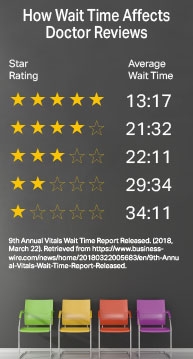
NEW WAIT TIME MANAGEMENT TECHNOLOGY BOOSTS PX
The healthcare profession is not generally known for winning awards for efficiency. But, let’s be fair. To a patient in need of competent medical attention, efficiency is not top of mind. Rather, receiving a diagnosis and prescribing treatment for a quick recovery, at any cost, is the number one priority. Efficiency leaves the house when the need for care is urgent or the level of discomfort reaches a certain threshold.
Fair enough?
Then let’s continue to beat the waiting room conundrum war drum for two reasons: First, because it’s a problem that must be resolved, and second, because it feels good. All of us have experienced unacceptable wait times that pushed our frustrations to pull-you-hair-out levels. Surely we’re all willing to beat the drums of war to make a change.
A Glimpse: What the Reception Area Can Be
Dentists have figured out the reception area. Granted, dentistry is not nearly as complex when it comes to scheduling; however, let’s admit that dentistry has set the bar. And the bar is quite high.
“Frontdesklessness” is a principle that a smattering of more progressive dentists apply to their practices. The premise is this: the practice knows that at a certain time a specific patient will walk into their office. A member of their team, therefore, keeps an eye on the door. When that patient enters the office, the team member walks into the reception area to personally greet them. If the operatory is ready, the patient is walked directly to the operatory and prepared for treatment. If the operatory is not ready, the patient is offered a chair and a beverage.
I’ve personally experienced the frontdeskless environment as a patient. It is remarkable and distinguishes the practice from all the other competing practices. Once you’ve experienced frontdesklessness, you never want to go back.
Imagine the medical practice that is able to provide a similar experience! Certainly, the patient experience, or Px, is catapulted to new heights. But, is there a business case for eliminating or significantly reducing wait times? If a practice invests the time and money, will it see an acceptable return?
Wait Time Effects Doctor Ratings
The folks at Vitals, the physician rating company, conduct an annual study on wait times. The correlation between the amount of time a patient waits to see a doctor and that doctor’s average rating is easy to spot. In their most recent study, released in March 2018, doctors with 5-star ratings posted a wait time average of 13:17. Doctors receiving only a one-star rating had wait times of more than 34 minutes!
Let’s be honest: if you had to wait 34 minutes to see a doctor are you going to give them more than one star? (Are you also shocked that we’ll wait more than thirteen minutes in a cough-infested reception area and still give the doctor five stars?)
Ratings are critical to every practice. Persons looking for a new physician are either asking a friend who they like, or they search online. Any doctor with less than four stars is losing multiple opportunities every day to acquire a new patient or family.
“We don’t need more patients,” I hear administrators say. “We are plenty busy.”
What may be true today may not be true tomorrow. And I use the word “may” because many administrators equate“plenty busy” to financial success. Lifetime value and patient ROI is a topic for another article; however, you should never assume “plenty busy” means your boat has come in. If your practice throws a blind eye to wait times and Px, you’re guaranteed to see a time when you’re not “plenty busy.”
Why Doctors Fail at Managing Schedules
Unlike their dental colleagues, physicians usually don’t know why a patient has scheduled an appointment. Generally speaking, the scheduling people are assigning patients to 10-minute blocks. In some cases, the doctor is able to see and treat a patient within that time frame. In other cases, more time is required. The achilles heel to this scheduling strategy is that it only takes one patient to ruin the Px for all other patients.
In other instances, the doctor may be called to an emergency situation, or stuck in traffic, abducted by aliens, or suddenly feeling ill. Infinite are the reasons why a doctor could be late getting to the office.
Contributing to long wait times are arduous patient intake processes. I recently needed to see a doctor of a large medical practice at one of their many locations. I entered the building and walked straight to a reception desk. The lady behind the desk was kind enough to ask for my name and which doctor I was seeing. She pounded the computer keyboard and then directed me to a kiosk to complete my check-in process.
The kiosk then asked for my name, which I’m pretty sure I just gave the lady behind the counter. Upon finding my appointment, the kiosk asked me to review four pages of personal information, in case my contact or insurance information had changed. At some point, my picture was taken, my insurance card scanned, and my credit card swiped. The experience was cold and inhuman. During this intake process, I ventured a glance at the lady behind the desk. She was catching up on Facebook. I think she enjoys the kiosk intake system more than I do.
When it was all over with, about two minutes later, I had to ask where to go next. Then I waited fifteen minutes to see the doctor. I am confident the patient intake technology is not improving the Px or reduce wait times. And this technology doesn’t come cheap! The kiosk is adding another barrier between me and my goal to see a doctor.
Upon careful reflection, all of the planets, moons, and stars must be aligned for every patient to wait next to nothing to see their doctor. Perhaps there’s a different way to look at the problem, because the planets, moons, and stars only align every one thousand years or so.
Treating the Symptoms to Improve Px
Imagine receiving a text message from your doctor that said, “Andy, this is Dr. Brown. I’m running 30 minutes behind today. Can we move your appointment to 2:30 or would you like to reschedule?”
Wow!
With that one considerate message my respect for my doctor just skyrocketed. Finally, a medical practice that respects my time as much as they value their own. Upon receiving the message I can reply to my doctor my preferences. If I wish to move my appointment to 2:30, the receptionist edits my appointment information. If I wish to reschedule, I can work out the details via text message with the receptionist.
The technology required to make this dream come true all ready exists. RelevantMD’s patient messaging technology, for example, now includes a feature that makes it possible for a front desk to message every patient with an appointment for the day via text message. The patient is notified of the backlog and given the option to come in later or reschedule. The technology automates the process to the point of your being able to complete the task in less than 30 seconds.
I know what you’re thinking. Sometimes the doctor is able to get back on schedule. So you wouldn’t want to change times for all appointments for the day; the daily production for the day would be needlessly decreased. The production wouldn’t be lost, only postponed; however, being able to bill for production now instead of later is a best practice.
In the case of RelevantMD’s technology there’s a nifty solution to this dilemma. When you send a “we’re behind schedule” text message, the system sends the message an hour or 45 minutes prior to the scheduled appointment time (you decide on the interval). The messages are not sent all at once. As a result, if the doctor does get back on schedule, the front desk can cancel any unsent messages.
One thing needs to be clear: RelevantMD’s wait time management features don’t cure the disease. Rather, they only treat the symptoms, for now. But treating the symptoms, by communicating with your patients when it matters most to them, is strapping a rocket engine to PX.
A Change of One Degree to Start
One of the most influential contributors to New Age philosophy, Deepak Chopra, quipped, “All great changes are preceded by chaos.” Surely the waiting room Px is in a state of disarray and surely the path forward is becoming more and more clear: engage the patient in meaningful conversation in order to avoid frustrating situations.
In air navigation, the 1 in 60 rule is a rule of thumb which states that for each degree of change over a distance of 60 nautical miles (NM), it will result in 1 NM off course. Thus, if a pilot makes a course change of 10 degrees, the plane will be 10 nautical miles away from its original destination after traveling 60 nautical miles.
One small change in your practice can lead to giant improvements in Px over time. Messaging your patients when the schedule is backed up, for example, is really a small change. But the net effect on Px can be huge.

